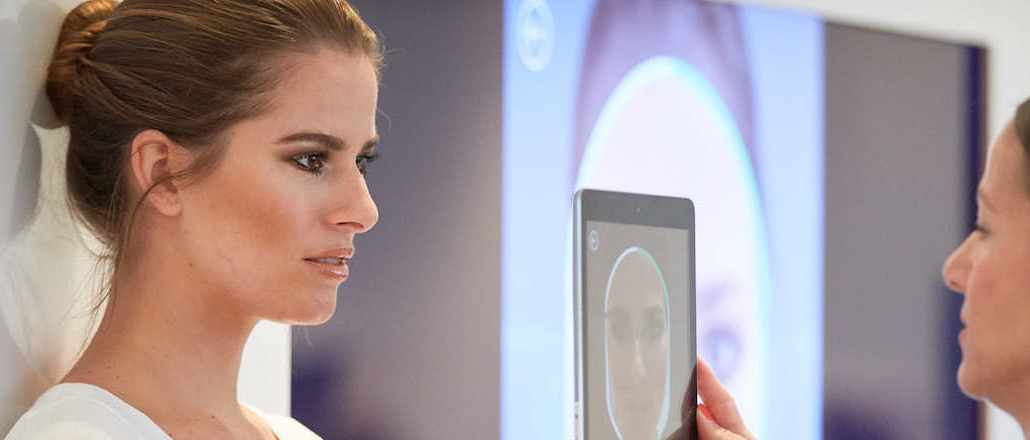
This story first appeared on Glossy, Digiday’s sister site about how tech is transforming fashion and luxury.
Bloggers now feature as frequently as big-name celebrities in brands’ marketing plans. But the young advertiser-influencer relationship is mired in confusion and opacity.
Now, Rimmel London is testing an interesting way to sidestep all the awkwardness, while piggybacking on influencers’ sway: The beauty brand released an augmented-reality app Thursday called Get The Look, which lets consumers “steal” a makeup look from anyone — bloggers, friends, strangers on the street — and try it on.
It’s effectively a Shazam for beauty fans. Using the front-facing camera, the free app captures the shape and color of the products on the user’s model of choice and finds the closest match in Rimmel’s library. Even if the user is zapping a vlogger paid by Benefit, say, they will still see Rimmel products.
The user can then view a simulation of these Rimmel products on their own face and order them via Google Shopping. Integration with Rimmel’s own website and e-commerce players like Boots are expected to follow.

It’s well-established that Gen Z can’t relate to traditional advertising. When they want product information, they go to their peers — be they friends or social influencers. According to an Ipsos report, 68 percent value the opinion of their peers when purchasing an item, versus 19 percent for banner ads and 34 percent for TV spots.
“We know these consumers are influenced more by a friend or a peer rather than a brand. We want to be involved in that,” Montse Passolas, Rimmel’s vp of global marketing, told Digiday.
As such, Rimmel’s social content is increasingly influencer-heavy. There are Snapchat takeovers and shoppable Youtube videos, but also a growing focus on micro-influencers. A recent #LondonLook competition flew 18 fans to the capital to create their own content around the brand. It received over 12,000 entries.

Besides tapping into the pulling power of those being zapped, Rimmel also wants Get The Look to pull in its own community of microinfluencers. Users on the app can share their virtual makeovers with friends on social media. They can also submit their photos to Rimmel’s gallery.
Downloads are important, but the key metric for Rimmel will be engagement. “If it uplifts sales as a consequence, then great. But it’s more than a sales tool. It’s about enhancing the consumer experience,” Passolas said.
As Rimmel looks to grow its global audience, the app will allow customers to interact with its products in areas that lack a bricks-and-mortar presence. In markets like Argentina and Spain, the app will have the dual aim of growing an engaged audience and acting as a substitute store experience.
The transition to e-commerce has been awkward for beauty brands. With few ways to try before they buy, a high proportion of consumers still buy their products in-store.
Augmented reality, which promises to make that store experience digital, is now old hat for beauty brands. Coty Inc, Rimmel’s parent company, has already released try-on apps like Sally Hansen’s ManiMatch and Covergirl’s BeautyU. L’Oreal’s Makeup Genius app — which has been downloaded over 6 million times — launched back in 2014.
“We didn’t want to be first or just launch as tech for tech’s sake. We wanted it to be perfect,” said Elodie Levy, Coty’s global digital director.

The app, which took six months to build, features over 300 Rimmel products. Holition, the agency behind it, has refined its image-recognition software, FACE, so that it is continuously learning from new additions to the 7,000 face shapes in its database.
On Rimmel’s side, it will be a continuous process of feeding in new looks and adding new functionality to the app.
Jonathan Chippindale, Holition’s CEO, told Digiday that while adoption had previously lagged with brands, the technology has made enough progress that the implementation can now match up to expectations. It’s no longer clunky, and there’s less of a risk of products being distorted, and thus dismissed.
“The mascara has not only got to look amazing but fit in the right places. A millimeter here and there will break the spell,” he said.
More in Marketing

Pitch deck: How Amazon is recasting Twitch as a core part of its CTV pitch
Amazon is positioning Twitch as a defining asset in its CTV ambitions.

Netflix transforms former mall department stores into experiential venues
The location in Dallas opens this week, and one at the King of Prussia mall near Philadelphia opened last month.

Future of Marketing Briefing: AI has created a new talent paradox in programmatic agencies
The job isn’t execution anymore. AI handles that. The job is judgement.





